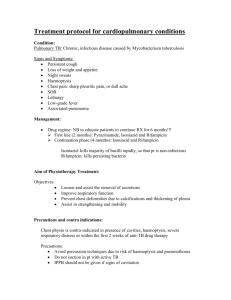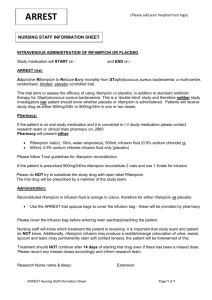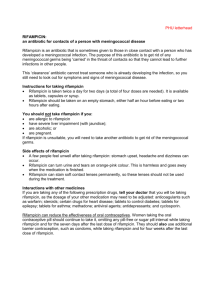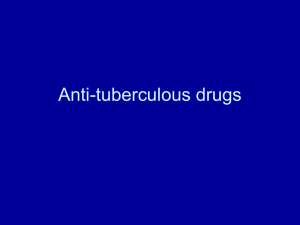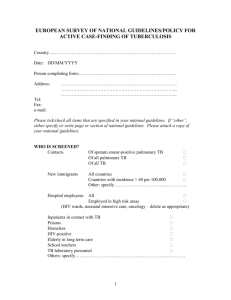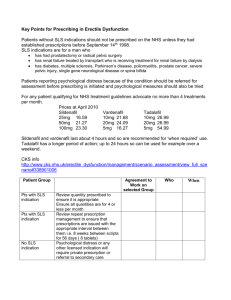INTRODUCTION Dissolution rate test forms an essential tool in
advertisement
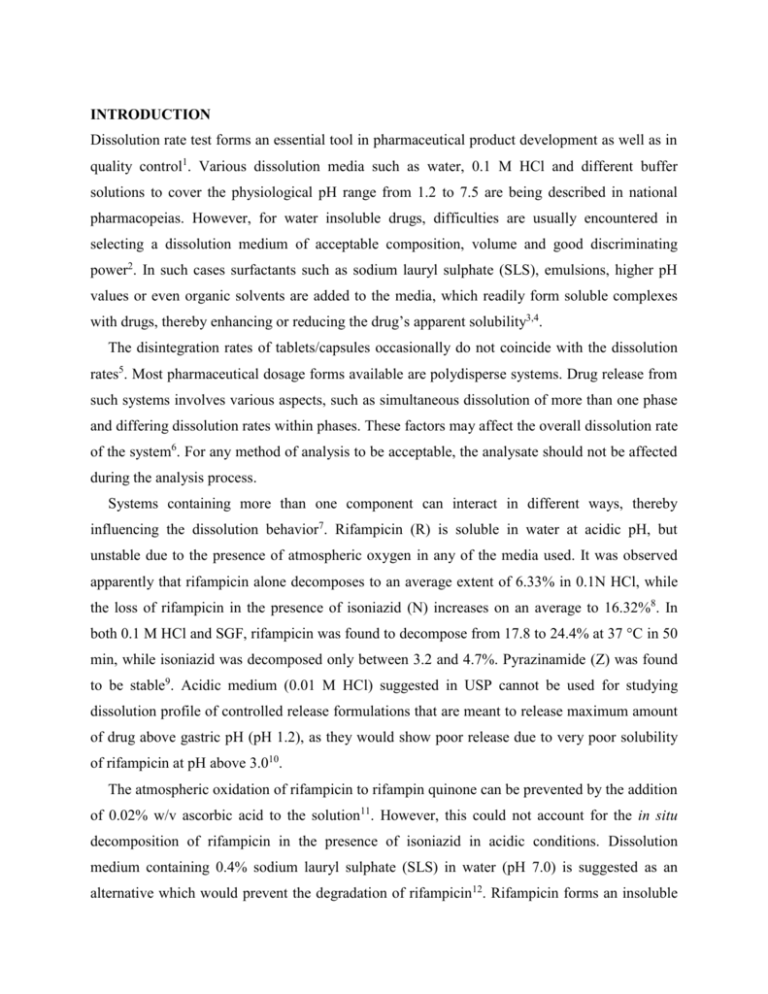
INTRODUCTION Dissolution rate test forms an essential tool in pharmaceutical product development as well as in quality control1. Various dissolution media such as water, 0.1 M HCl and different buffer solutions to cover the physiological pH range from 1.2 to 7.5 are being described in national pharmacopeias. However, for water insoluble drugs, difficulties are usually encountered in selecting a dissolution medium of acceptable composition, volume and good discriminating power2. In such cases surfactants such as sodium lauryl sulphate (SLS), emulsions, higher pH values or even organic solvents are added to the media, which readily form soluble complexes with drugs, thereby enhancing or reducing the drug’s apparent solubility3,4. The disintegration rates of tablets/capsules occasionally do not coincide with the dissolution rates5. Most pharmaceutical dosage forms available are polydisperse systems. Drug release from such systems involves various aspects, such as simultaneous dissolution of more than one phase and differing dissolution rates within phases. These factors may affect the overall dissolution rate of the system6. For any method of analysis to be acceptable, the analysate should not be affected during the analysis process. Systems containing more than one component can interact in different ways, thereby influencing the dissolution behavior7. Rifampicin (R) is soluble in water at acidic pH, but unstable due to the presence of atmospheric oxygen in any of the media used. It was observed apparently that rifampicin alone decomposes to an average extent of 6.33% in 0.1N HCl, while the loss of rifampicin in the presence of isoniazid (N) increases on an average to 16.32%8. In both 0.1 M HCl and SGF, rifampicin was found to decompose from 17.8 to 24.4% at 37 °C in 50 min, while isoniazid was decomposed only between 3.2 and 4.7%. Pyrazinamide (Z) was found to be stable9. Acidic medium (0.01 M HCl) suggested in USP cannot be used for studying dissolution profile of controlled release formulations that are meant to release maximum amount of drug above gastric pH (pH 1.2), as they would show poor release due to very poor solubility of rifampicin at pH above 3.010. The atmospheric oxidation of rifampicin to rifampin quinone can be prevented by the addition of 0.02% w/v ascorbic acid to the solution11. However, this could not account for the in situ decomposition of rifampicin in the presence of isoniazid in acidic conditions. Dissolution medium containing 0.4% sodium lauryl sulphate (SLS) in water (pH 7.0) is suggested as an alternative which would prevent the degradation of rifampicin12. Rifampicin forms an insoluble ion-pair complex with SLS which is hydrophobic in nature and tends to precipitate in acidic media. While in alkaline pH, rifampicin started to release from the SLS mixture of rifampicin in alkaline media is attributed to wetting and solubilization properties of sodium lauryl sulphate13. It is proposed that rifampicin forms 3-formylrifamycin under acidic conditions, which interacts with isoniazid to form isonicotinyl hydrazone14. Addition of SLS would spare rifampicin from conversion to 3-formylrifamycin and also prevent decomposition of isoniazid by not forming hydrazone. Pyrazinamide also reacts the same way with rifampicin to form pyrazine carboxylic acid, but with less tendency for reaction than isoniazid due to lack of secondary nitrogen found on the hydrazide group of isoniazid, which results in the instabilities of rifampicin. Pyrazinamide condenses with isoniazid to form hydrazine, which accounts for the instabilities of pyrazinamide. However, a high concentration of SLS tends to reduce the discriminating power between the different forms of poorly water soluble drug products15. Therefore, the aim of this study was to develop a suitable dissolution medium for in vitro evaluation of rifampicin, isoniazid and pyrazinamide fixed-dose formulation was developed basing on its solubility, stability and dissolution rate of the three drugs in the presence of SLS and ascorbic acid in various aqueous media. In the present study, solid state characteristics of drug ion pair complex was also investigated using DSC, FTIR and XRD analysis. A dissolution medium with significant discriminating power to evaluate the in-vitro dissolution rate of two commercial brands of anti-tubercular FDC tablets was selected. MATERIALS AND METHODS Rifampicin, isoniazid and pyrazinamide were gift samples from Lupin, Hyderabad. Sodium lauryl sulfate and potassium dihydrogen ortho phosphate AR were obtained from Sigma chemicals and Qualigen fine chemicals respectively. Ascorbic acid, sodium hydroxide pellets and hydrochloric acid of analytical grade were procured from S.D. fine chem. Ltd, Mumbai. Two commercial brands of anti-tubercular FDC products: brand A: Rinizide® containing isoniazid100mg, pyrazinamide-500mg, rifampicin-150mg (batch No. A2026SU, Lupin Ltd.) and brand B: Macox® containing isoniazid-100mg, pyrazinamide-500mg, rifampicin-150mg (batch No. FRB9102A, Macleods pharmaceuticals Ltd.) were tested in the present study. Solubility Determination Solubility of R, N and Z in both acidic (pH 1.2) and basic media (pH 6.8) was determined by shake flask method. Excess R, N and Z was added individually to 20ml of each fluid taken in a 25mL stoppered conical flask and the mixtures were shaken for 12 hours at room temperature (28°±1°C) on a rotary flask shaker. After 12 hours of shaking, 2 mL aliquots were withdrawn at 1 hour intervals and filtered immediately using a 0.45 µ disc filter. The filtered samples were diluted suitably and assayed for R, N and Z by measuring absorbance at 475, 263 and 268 nm using the corresponding fluid as blank. Shaking continued until two consecutive estimations are the same. The solubility of R, N and Z in 0.1 N HCl containing different concentrations of SLS was also determined at room temperature (28°±1°C) to find out the effect of surfactant on drug solubility. The solubility experiments were conducted in triplicate. Stability Determination Accurately weighed quantities of the three drugs R, H and Z were dissolved completely in 300 mL of each of 0.1 N HCl. Drug solution, of 300 mL (containing R, H and Z) in 0.1 N HCl was divided into six volumetric flasks equally so that each volumetric flask contained 50 mL drug solution and was labeled as A, B, C, D, E and F. Concentrations of SLS ranging from 0, 0.05, 0.1, 0.15 and 0.2% were added to the five volumetric flasks containing acidic media viz., B, C, D, E and F respectively. 0.02% ascorbic acid was added to five of the six volumetric flasks excepting A. In the same way, 150 mL of drug solution containing accurately weighed quantities of R, H and Z was prepared in phosphate buffer solution. It was divided equally into three volumetric flasks and was labeled as G, H and I. Concentrations of SLS ranging from 0, and 0.1% were added to the two volumetric flasks containing basic media viz., H and I respectively. 0.02% ascorbic acid was added to two of the three volumetric flasks except G. Three milliliters, aliquots from each volumetric flask taken were appropriately diluted and assayed for R, H and Z by measuring absorbance at 475, 263 and 268 nm using the corresponding fluid as blank. The stability of the three drugs was studied for a period of 30 h in both 0.1 N HCl and pH 6.8 phosphate buffer. Fourier Transform Infra-Red Spectroscopic Studies Infra-red (IR) spectroscopy studies of rifampicin, sodium lauryl sulphate (SLS) and rifampicin SLS complex (1:1 molar ratio) were recorded in a FTIR spectrophotometer (Bruker FTIR). Potassium bromide pellet method was employed at a hydrostatic pressure of 5 tones/ cm2 for two minutes and background spectrum was collected under identical conditions. Each spectrum was derived from 16 single average scans collected in the region of 400-4000cm-1 at a spectral resolution of 2cm-1. Powder X-Ray Diffraction Studies The powder X-ray diffraction pattern of rifampicin, sodium lauryl sulphate (SLS) and rifampicin SLS complexes in three different molar ratios of 1:2, 1:1 and 2:1 were recorded using a Shimadzu X-RD 6000 with Cu as anode material and crystal graphite monochromator applied at a voltage of 40 KV. The selected samples were analyzed in the 2θ angle range of 0 to 60°. Differential Scanning Calorimetry Differential scanning calorimetry (DSC) was performed to study the thermal stability and changes in crystallinity over a range of temperatures. Thermographs of rifampicin, sodium lauryl sulphate (SLS) and rifampicin SLS complexes in three different molar ratios of 1:2, 1:1 and 2:1 were taken using DSC Q10 V9.0 Build 275, TA Instruments, USA. A known mass of sample (39 mg) was placed in an aluminum pan and a lid was crimped onto the pan before heating at the scanning rate of 10 °C/min over the temperature range of 35 °C-350 °C. The pan was then placed in the sample cell of a DSC module .The temperature of the DSC module was equilibrated at 35 °C and then increased at a rate of 10 °C/min under a N2 gas purge until the material began to degrade. An empty aluminum pan was used as a reference sample. The temperatures were obtained for each peak in the resulting curve provided indications of temperature stability and phase transitions. In vitro Dissolution Rate Study The dissolution rate of the two commercial brands of anti-tubercular FDC tablets under study were determined at 37±1C using a USP XXI 8-station dissolution rate test apparatus (DS 8000, Lab India, Mumbai) with a paddle rotating at 50 rpm. The dissolution media used was 900mL of 0.1 N hydrochloric acid (pH 1.2)/0.1 N hydrochloric acid containing 0.1 % SLS and 0.02% ascorbic acid for two hours. Samples of dissolution media were withdrawn at 0, 5, 10, 20, 30, 45, 60, 90 and 120 minutes and filtered using a 0.45µ nylon disc filter. Samples were suitably diluted with the respective dissolution medium and assayed for R, N and Z by measuring absorbance at 475, 263 and 268 nm using the corresponding fluid as blank. The dissolution experiments were conducted in triplicate. RESULTS AND DISCUSSION Solubility Determination Approaches usually used in the design of dissolution media for poorly soluble drugs to maintain sink condition (i.e., a large difference in the dissolved drug concentration and saturation drug concentration) include a) bringing about drug solubility by increasing the volume of the aqueous sink or removing the dissolved drug, b) solubilization of the drug by co-solvents up to 40% , by anionic or non-ionic surfactants added to the dissolution medium in post micellar concentration and c) alteration of pH to enhance the solubility of ionizable drug molecules 16,17. Solubility plays a prime role in the dissolution of a drug substance from a solid dosage form. Correlation between solubility and dissolution rate of different drug substances in various media are well established18,19. In this study, solubility data was used as a basis for the development of dissolution medium for rifampicin, isoniazid and pyrazinamide fixed-dose formulation. The solubility of R, N and Z was determined at room temperature (28°±1°C) in different fluids. The solubility of R, N and Z were 200.2 and 9.9, 174.9 and 153.2, 22.7 and 22.3 mg/ml respectively in 0.1 N hydrochloric acid (pH 1.2) and pH 6.8 phosphate buffer. These results indicated that rifampicin is poorly soluble at alkaline pH but freely soluble at acidic pH, isoniazid is freely soluble at both acidic and basic pH, and pyrazinamide is sparingly soluble at both acidic and basic pH. Hence, alteration of pH of the dissolution fluid cannot be used for rifampicin, isoniazid and pyrazinamide combination to maintain sink condition. The effect of surfactant such as sodium lauryl sulphate on the solubility of the three drugs was studied. The solubility of isoniazid and pyrazinamide were increased as the concentration of SLS was increased in acidic media due to the wetting, solubilization/deflocculation properties of the surfactant. The solubility of rifampicin was lower at pH 6.8 and higher at pH 1.2. The solubility of rifampicin was increased by 1.23-fold, 1.48-fold and 1.74-fold with 0.2%, 0.3% and 0.4% concentration of SLS, respectively in 0.1 N HCl medium. On the other hand, the solubility of rifampicin was decreased by 0.6-fold with 0.1% concentration of SLS in 0.1 N HCl, indicating the formation of insoluble ion-pair complex between rifampicin and SLS. Addition of sodium lauryl sulphate (SLS) in 1:1 molar ratio decreased the solubility of rifampicin due to formation of rifampicin-SLS ion-pair complex which is hydrophobic in nature and tends to precipitate at acidic pH. Based on the solubility data, hydrochloric acid (0.1 N) fluids containing 0.1%, 0.2% and 0.3% SLS were selected as dissolution media for rifampicin, isoniazid and pyrazinamide combination. These fluids provide a satisfactory sink condition needed for the dissolution rate test which was further confirmed by the stability determination of the three drugs combination in these fluids. Stability Determination The results shown in Fig 1 indicated that in 0.1 N HCl, degradation starts rapidly from the beginning (A). Addition of ascorbic acid alone does not prevent the degradation of rifampicin in acidic medium (B). Addition of 0.05% (C), 0.15% (E) and 0.2% w/w SLS (F) could not maintain the drug stable for more than 24 hrs. This was prevented by the addition of SLS at a concentration of 0.1% (D) and the drug remains stable for more than 24 hrs. The similar result was observed with isoniazid and pyrazinamide being more stable in solution containing 0.1% SLS and 0.02% ascorbic acid. This may attributed to the formation of an insoluble ion-pair complex of SLS with rifampicin at 0.1 % w/w concentration of SLS, which tends to precipitate at acidic pH, thus sparing rifampicin from interaction with isoniazid or pyrazinamide. Unlike in 0.1 N HCl, phosphate buffer of pH 6.8, degradation started slowly (G) as shown in Fig 2. The atmospheric oxidation of rifampicin to rifampin quinone can be prevented by the addition of ascorbic acid (200 µg/ml) alone (H) to the buffer and the drug remains stable for more than 24 hrs. The stability profile of rifampicin in the presence of SLS (I) was slightly decreased than that of H profile, which may be possibly attributed to the solubilization and wetting properties of SLS in alkaline media, allowing more amount of drug to be available in soluble form. The stability profile of isoniazid and pyrazinamide remain stable for a period of more than 24 hrs in all the three fluids (G, H and I). Basing on the stability profiles, 0.1 N hydrochloric acid containing 0.1% SLS and 0.02% ascorbic acid, phosphate buffer of pH 6.8 containing 0.02% W/V ascorbic acid were selected as dissolution media for rifampicin, isoniazid and pyrazinamide combination as the anti-tubercular drugs remained stable for a period of more than 24 hrs. Analytical Determination The solid-state characteristics of drug in the SLS complexes were carried out to notify whether there exists a physical interaction such as change in polymorph, melting point, hygroscopicity or strong to mild chemical interaction such as ionic/ coordinate/ covalent bond formation among the drug and SLS. The interaction studies for the drug in the complex form was studied using different analytical techniques such as Fourier transform spectroscopy (FTIR), differential scanning calorimetry (DSC) and X- ray diffraction (XRD) studies. Fourier Transform Infra-Red Spectroscopic Studies The IR spectral studies emphasized on the active functional groups of the drug molecule which are more susceptible for chemical interaction with other active functional; group of the excipients or polymer. The IR – Spectral studies were performed for the pure drug and for its preformulation of interest excipient / polymers by KBr (cm-1) pellet technique by Bruker Spectrophotometer at the resolution of 4 cm-1. The IR spectrums of pure drug were interpreted for its functional and structural features of the drug based on the characteristic absorption bands in cm-1. The appropriate absorption band for the vibrational frequency of functional group/ structural fragment of the pure spectrum is compared with its spectrum of formulation for the presence of characteristic functional group in the same wave number. The change/shift of the characteristic peaks of rifampicin in the drug complex system indicates that some sort of solidstate interactions exists between rifampicin and sodium lauryl sulphate. The FTIR studies showed that the significant peaks of rifampicin were OH stretch at 3424 cm1 , C-H stretch at 2970 cm-1, furanone C=O absorption at 1736 cm-1, acetoxyl C=O vibration at 1710 cm-1, amide NH-C=O at 1656 cm-1 and C=C vibration at 1562 cm-1. Sodium lauryl sulphate showed two significant peaks i.e., SO2 stretch at 1220 cm-1 (asymmetric) and 1084 cm-1 (symmetric). The freshly prepared co-ground rifampicin–sodium lauryl sulphate mixture (1:1) showed characteristic peaks of two carbonyl peaks acetoxyl C=O at 1710 cm -1 and furanone C=O absorption at 1736 cm-1 of rifampicin shifted to 1733 cm-1. The –NrifampiCH3 and hydroxyl (-OH) stretch of rifampicin observed at 2970 and 3424 cm-1 were shifted to 2967 and 3448 cm-1 corroborating that some sort of physical-state interactions exists between rifampicin and sodium lauryl sulphate. The sodium lauryl sulphate peaks at 1220 cm-1 (asymmetric) and 1084 cm-1 (symmetric) does not exhibit significant change (Fig 3). The presence or absence of characteristic peak associated with specific structural group of drug molecule was noted as shown in Table 2. Powder X-Ray Diffraction Studies Powder X-Ray diffractometry (XRD) is a useful method for the detection of complexation with the polymer blend matrix in powder or microcrystalline form. Crystallinity was determined by comparing the pure drug peak height at 19.9° (2θ) with those of the drug SLS complex systems. The relationship used for the calculation of crystallinity was relative degree of crystallinity (RDC). RDC= Isam / Iref, Where Isam is the peak height of the sample under investigation and Iref is the peak height at the same angle for the reference with the highest intensity20. Powdered X-ray diffraction patterns of rifampicin and its complex systems with sodium lauryl sulphate in 1:2, 1:1 and 2:1 ratio of rifampicin: SLS were shown in Fig 4 and percent relative degree of crystallinity values are given in Table 3. The X-Ray diffractogram of rifampicin exhibited sharp peaks at diffraction angles of 2θ at 11.1º and 19.9° with intensity of 2517.1 and 2675.6, indicating the presence of drug in crystalline from (polymorph II of rifampicin). The X-ray powder diffraction pattern of sodium lauryl sulphate exhibited characteristic peaks at 20.4º and 20.7º with intensity of 5021.5 and 5215.2, indicating the presence of crystallinity. The X-ray powder diffraction pattern of 1:1 ground mixture of rifampicin-sodium lauryl sulphate indicated the characteristic peaks of sodium lauryl sulphate at 20.4° and 20.8º, while the characteristic peaks of rifampicin were shifted significantly towards lower intensity (10.1º and 18.9º), indicating a greater amorphousness of the complex systems, compared to the free molecules. Rifampicin therefore existed in a less crystalline state in the ground mixture as compared to rifampicin alone. Pure drug peak at 19.9◦ (2θ) was shown without any shift/change in both 1:2 and 2:1 molar ratio of rifampicin: SLS complex systems. The % RDC values of the SLS complexes was less than that of the drug in 1:1 molar ratio complexes and increased in the case of 1:2 and 2:1 molar ratio complexes of rifampicin: SLS. This indicates the ion pair complex between cationic nitrogen of rifampicin and anionic lauryl sulphate of SLS in 1:1 molar ratio. Differential Scanning Calorimetry DSC was performed to investigate the possible solid-state interactions between the components by conducting the thermal analysis of the samples under inert atmosphere. The crystallinity level is obtained by measuring the enthalpy of fusion for a sample (ΔHf) and comparing it to the enthalpy of fusion for the fully crystalline material (ΔHf) crystal21. The DSC thermograms of rifampicin and its complex systems with sodium lauryl sulphate in 1:2, 1:1 and 2:1 ratio of rifampicin: SLS are shown in Fig 5 and fractional crystallinity [(ΔHf) sample / (ΔHf) crystal] values are given in Table 4. The DSC curve of rifampicin showed the presence of FORM II crystalline polymorph of the drug, which is undergoing a thermal rearrangement at about 38.6 ºC. The characteristic melting point peak was observed at 185.6 ºC and followed by its recrystallization at 207.1 ºC to FORM I polymorph. The drug undergoes decomposition thereafter characterized by the exothermic incline of the peak. The DSC curve of SLS showed three endothermic peaks at 96.8ºC (associated with loss of water), 191.7ºC (melting point peak) and 218.0ºC followed by degradation. DSC curve of co-ground mixture of 1:1 molar ratio of rifampicin: SLS showed a broad endothermic peak away from the melting point of rifampicin at 90.3°C. As the melting points of the rifampicin has shown significant shift in the thermogram of 1:1 M complex, it may be concluded that there is formation of complex between rifampicin and sodium lauryl sulphate. However, in the case of 1:2 and 2:1 molar ratio of rifampicin: SLS complexes, there was no significant shift in the melting points of rifampicin, indicating that the drug has not formed an inclusive complex with SLS and the drug may be free from chemical interaction. The reduction in fractional crystallinity values of the R-SLS complexes in 1:1 molar ratio was decreased when compared to the drug and increased in the case of 1:2 and 2:1 molar ratio complexes. This indicates the absence of crystalline drug and its complete complexation with SLS in 1:1 molar complex. In Vitro Dissolution Rate Study The dissolution rate of tablets is usually dependent on the characteristics of the release medium including the solvent action and formulation of tablet. The sensitivity of the medium to tablet formulation and manufacturing variables markedly affect the discriminating power of a dissolution medium. Dissolution rate of the two commercial brands of anti-tubercular FDC tablets were studied in (a) 0.1 N HCl (pH 1.2) and (b) 0.1 N HCl containing 0.1% SLS and 0.02% ascorbic acid as dissolution media at 37 C. Fig 6 shows the dissolution profile of the two brands of anti-tubercular FDC tablets in 0.1N HCl (pH 1.2). No significant difference in the dissolution rate between two brands of anti-tubercular FDC tablets was observed. Fig 7 shows the dissolution profile of the two brands of anti-tubercular FDC tablets in 0.1 N HCl containing 0.1% SLS and 0.02% ascorbic acid as medium. A marked difference in dissolution between the two brands of anti-tubercular FDC tablets was observed in modified medium. The results indicated that 0.1 N HCl containing 0.1% SLS and 0.02% ascorbic acid as dissolution medium exhibited good discriminating power i.e., significant differences in the two brands was observed in this fluid when compared to dissolution medium of 0.1 N HCl. Because of high solubility of rifampicin in 0.1 N HCl, the variations in the dissolution character of the two brands are nullified. Moreover, the drug release was at a much lower rate in 0.1 N HCl because of the acceleration of degradation of rifampicin and enhanced interaction with isoniazid and pyrazinamide in acidic media. Using 0.1 N hydrochloric acid containing 0.1% SLS and 0.02% ascorbic acid as the release medium allowed higher release of isoniazid, rifampicin and pyrazinamide comparatively. This may be attributed to the ion-pair complexation of sodium lauryl sulphate with rifampicin at acidic pH, thus sparing rifampicin from interaction with isoniazid or pyrazinamide. Ascorbic acid at a concentration of 0.02% (w/v) prevents rifampicin from atmospheric oxidation. Based on these observations, 0.1 N HCl with 0.1% SLS and 0.02% ascorbic acid is selected as a dissolution medium with good discriminating power. It is also suggested that using organic solvents and surfactants in dissolution media should require great care and it is better to use the lowest possible concentration of surfactants and organic solvents in dissolution media. CONCLUSION Rifampicin, isoniazid and pyrazinamide are the three frontline anti-tubercular drugs. Isoniazid and pyrazinamide are highly soluble in the aqueous medium and absorbed throughout the gastrointestinal tract. Rifampicin is a highly variable drug and is poorly permeable across the gastrointestinal tract. Rifampicin undergoes atmospheric oxidation to rifampin quinone, which can be prevented by the addition of 0.02% w/v ascorbic acid in mildly alkaline solutions. However, this could not account for the in situ decomposition of rifampicin in the presence of isoniazid and pyrazinamide in acidic solutions. Addition of SLS would spare rifampicin in acidic media from conversion to 3-formylrifamycin and thus preventing interaction with isoniazid and pyrazinamide. Basing on the solubility, stability and dissolution rate of the three drugs in the presence of SLS and ascorbic acid conducted in various aqueous media, a dissolution medium of 0.1 N HCl with 0.1% SLS and 0.02% ascorbic acid, and pH 6.8 phosphate buffer containing 0.02% ascorbic acid was found to be more suitable for studying the release profiles of rifampicin, isoniazid and pyrazinamide in fixed dose formulations. ACKNOWLEDGEMENTS The authors are grateful to the University Grants Commission, New Delhi, India for granting Junior Research Fellowship in Engineering and Technology, to carry out this work. The authors would like to express their gratitude to M/s Lupin Pharma Pvt. Ltd. for supplying the gift samples of rifampicin, isoniazid and pyrazinamide. REFERENCES 1. Qureshi SA, Gilvery MC. Typical variability in drug dissolution testing: study with USP and FDA calibrator tablets and a marketed drug (glibenclamide) product. Eur J Pharm Sci. (1999) 7, 249-58. 2. Lobenberg R, Kramer J, Shah MP, Amidon GL, Dressman JB. Dissolution testing as aprognostic tool for drug absorption: dissolution behavior of glibenclamide. Pharm Res. (2000) 17, 439-44. 3. Shah VP, Konecny JJ, Everett RL, MCCullough B, Noorizadeh A, Skelly JP. In vitro dissolution profile of water-insoluble drug dosage forms in the presence of solubilizers. Pharm Res. (1989) 6, 612-18. 4. Carmichael GR, Shah SA, Parrott EL. General model for dissolution rates of n-component, nondisintegrating spheres. J Pharm Sci. (1981) 70, 1331-38. 5. Hamed MA. Dissolution, Bioavailability and Bioequivalence. In: Gennaro A, Migdalof B, Hassert GL and Medwick T (eds.) Pennsylvania, Mack, Easton (1989) 55-72. 6. Higuchi WI, Mir NA, Desai SJ. Dissolution rate of polyphase mixtures. Pharm Sci. (1965) 54, 1405-10. 7. Banakar UV. Pharmaceutical Dissolution Testing. In: Swarbrick J (eds.) Marcel Dekker, New York (1992) 19-51. 8. Shishoo CJ, Shah SA, Rathod IS, Savale SS, Kotecha JS, Shah PB. Stability of rifampicin in dissolution medium in presence of isoniazid. Int J Pharm. (1999) 190, 109–23. 9. Singh S, Mariappan TT, Sharda N, Singh B. Degradation of rifampicin, isoniazid and pyrazinamide from prepared mixtures and marketed single and combination products under acid conditions. Pharm and Pharmacol Commun. (2000) 6, 491–94. 10. Gharbo SA, Cognion MM, Williamson MJ. Modified dissolution method for rifampin. Drug Dev Ind Pharm. (1989) 15, 331-35. 11. Sreenivasa Rao B, Ramana murthy KV. Development of dissolution medium for rifampicin sustained release formulations. Indian J Pharm Sci (2001) 258-60. 12. Jindal KC, Chaudhary RS, Singla AK, Gangwal SS, Khanna S. Dissolution test method for rifampicin–isoniazid fixed dose formulations. J Pharm Biomed Analy. (1994) 12, 493–97. 13. Satish Balkrishna Bhise, Sevukarajan Mookkan. Formulation and evaluation of novel FDCs of antitubercular drugs. J Pharm Res (2009) 2, 437-44. 14. Singh S, Mariappan TT, Sharda N, Kumar S, Chakraborti AK. The reason for an increase in decomposition of rifampicin in the presence of isoniazid under acid conditions. Pharm and Pharmacol Commun (2000) 6, 405–10. 15. Swanepoel E, Liebenberg W, Devarakonda B, Villiers MM. Developing a discriminating dissolution test for three mebendazole poly-morphs based on solubility differences. Pharmazie. (2003) 58,: 117-21. 16. Crisone JR, Weiner ND, Amidon GL. Dissolution media for in vitro testing of waterinsoluble drugs: effect of surfactant purity and electrolyte on in vitro dissolution of carbamazepine in aqueous solutions of sodium lauryl sulfate. J Pharm Sci. (1997) 86, 38488. 17. Crisone JR, Shah VP, Skelly JP, Amidon GL. Drug dissolution into micellar solutions: development of a convective diffusion model and comparison to the film equilibrium model with application to surfactant-facilitated dissolution of carbamazepine. J Pharm Sci. (1996) 85, 1005-11. 18. Nicklasson M, Brodin A, Nyqvist H. Studies on the relationship between solubility and intrinsic rate of dissolution as a function of pH. Acta Pharm Suec. (1981) 18, 119-28. 19. Nicklasson M, Brodin A. The relationship between dissolution rate and solubilities in the water-ethanol binary solvent system. Int J Pharm. (1984) 18, 149-56. 20. Ryan JA. Compressed pellet X-ray diffraction monitoring for optimization of crystallinity in lyophlilized solids: imipenem: cilastatin sodium case. J Pharm Sci. (1986) 75, 805-07. 21. Douglas A Skoog, James Holler F, and Stanley R Crouch. Principles of Instrumental analysis: Thermal methods. 2nd ed. (2007) 894-906. Table 1: Solubility of rifampicin, isoniazid and pyrazinamide in various fluids Solubility (mg/mL)* Drug Fluid Percent of surfactant (%w/v) Composition 0 0.1 N HCl (pH Rifampicin 0.4 - - - - - - - - Phosphate 9.9 ± buffer (pH 6.8) 0.10 0.1 N HCl - 200.2 ± 120.8 ± 246.3 ± 296.7 ± 360.1 ± 0.78 0.08 0.05 0.02 0.04 - - - - - - - - 1.2) Phosphate 174.9 ± 0.57 153.2 ± buffer (pH 6.8) 0.80 0.1 N HCl - 174.9 ± 987.2 ± 3312 ± 5053.1 ± 7742 ± 0.57 0.93 0.33 0.98 1.01 - - - - - - - - SLS 0.1 N HCl (pH 1.2) Phosphate 22.7 ± 0.10 22.3 ± buffer (pH 6.8) 0.12 0.1 N HCl - 22.7 ± 107.9 ± 362.1 ± 552.4 ± 846.3 ± 0.10 0.47 0.33 0.33 0.66 SLS *(mean ± S.D., n=3) 0.3 0.78 0.1 N HCl (pH Pyrazinamide 0.2 1.2) SLS Isoniazid 200.2 ± 0.1 Table 2: Wave number values (cm-1) from FTIR studies of rifampicin (R), sodium lauryl sulphate (SLS) and their complex system Code R O-H C=O N-H C-H S=O Band Band Band Band Band 3424 1710 1656 2970 (stretch) (stretch) (stretch) (stretch) 1220, SLS - - - - 1084 (stretch) RSLS (1:1) 3448 1733 1652 2967 (stretch) (stretch) (stretch) (stretch) 1220, 1084 (stretch) Table 3: % RDC values from X-Ray Diffractograms of rifampicin (R) and its complex systems with sodium lauryl sulphate (SLS) Product 2θ % RDC Rifampicin 2675.6 - SLS 5215.2 - R-SLS (1:2) 3082.3 115.2 R-SLS (1:1) 1244.5 46.5 R-SLS (2:1) 4411.9 164.9 Table 4: DSC studies of rifampicin and its complex systems with sodium lauryl sulphate Product DSC (ºC) Tpeak (ºC) ΔHfusion (J/g) Fractional crystallinity (%) Rifampicin 185.6 28.11 - SLS 191.7 4.28 - R-SLS (1:2) 189.2 27.07 96.30 R-SLS (1:1) 90.3 22.24 79.12 R-SLS (2:1) 186.1 28.29 100.64
